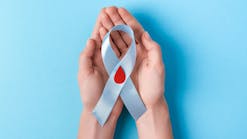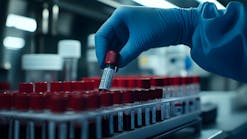The mapping of the human genome is helping to usher in a more personalized approach to medical intervention. Knowledge of an individual’s genomic makeup can help predict if that person might be predisposed to specific diseases. Such knowledge can be used by physicians to monitor patients for clinical signs of early disease that might have otherwise been overlooked, leading to more positive outcomes. In addition, genomic data can be used to tailor specific drug treatment by helping to predict how an individual might respond to a particular drug; if a patient might be predisposed to an adverse response; and/or the appropriate therapeutic dosage. The availability of such information is also encouraging the joint development of therapeutic treatments and corresponding “companion diagnostics” that can be used to predict if a particular drug should be administered to a specific patient in the first place. Such “gate-keeping” tests can be used to discriminate which patients are more likely to favorably respond to a particular drug, while at the same time excluding those patients not genetically equipped to respond. Such testing can also help to reduce possible adverse effects that might have been experienced by patients not genetically predisposed to benefit from the drug. Moreover, the growing cost of health care can be lowered by a policy of providing a particular drug only to those individuals who can be expected to benefit from the drug.
Education of the medical community, as well as the general population as a whole, will be necessary to diminish a number of bioethical concerns and questions related to molecular diagnostics. Denying drug treatments to a subset of patients, particularly those who might view the treatments as their only available lifesaving option, could be easily misconstrued by those patients as an impersonal, life-threatening, and possibly discriminatory decision, if the underlying facts are not clearly conveyed and understood.
Despite those issues, the availability of genetic data is transforming the drug development process by improving the manner in which all parties (pharmaceutical companies, diagnostic companies, physicians, payers, and regulatory agencies) strive to protect and meet the needs of patients. The paradigm shift from “one size fits all” to a more precise, tailored therapeutic approach can be expected to continue as more and more data demonstrate the therapeutic value of genetic screening prior to initiation of drug treatment. This paradigm shift, however, will clearly come at a cost to Big Pharma, since the marketing of “blockbuster” drugs to the masses will be replaced by a more refined, tailored approach. If all medications were offered to patients based upon a “personalized” approach, the total number of patients offered specific drug treatments would be reduced. Factoring in the high cost of drug development, such a change represents a potential disincentive to the pharmaceutical industry. On the other hand, the use of companion diagnostics during new drug development can be expected to increase that drug’s efficacy rates, since potential clinical trial enrollees can first be stratified into “responders” and “nonresponders,” with only the former entered into trials.
The ultimate potential benefit of personalized medicine will be safer medical intervention, along with a reduction in overall healthcare costs in the U.S. and abroad. Payers must also embrace this approach in order to achieve fair and equitable reimbursement of the molecular diagnostic testing required to assure the best possible clinical outcome.
Use of personalized medicine to help predict appropriate therapeutic dosage
The use of genomic data to more effectively predict appropriate dosing of warfarin (Coumadin) is a good example of the power of the underlying genomic data. Each year approximately 2 million people in the United States begin warfarin therapy, resulting in more than 30 million prescriptions filled to prevent or treat blood clots.1 Although the medication has proven to be very effective, it is not surprising that it also routinely ranks among the top five medications most frequently associated with adverse drug reactions (ADR).2,3 Prior to the availability of such data, a physician would have to initiate drug therapy based upon available clinical information such as clinical history, height, weight, other medications being used, etc. Using a “trial and error” approach, the physician would initiate therapy and then monitor the patient by repeated PT/INR testing. The results of such testing would allow the physician to essentially titrate the drug dosage up or down. If the initial dose was too low, the patient would remain at continued risk for an embolism, while too high a dose would subject the patient to the risk of possible cerebral hemorrhage.
Genomic data, however, can help to predict whether a person is at risk of a bleeding event in response to a high dose of warfarin.4-6 It can establish more effective therapeutic doses and subsequently reduce ADRs. Various single nucleotide polymorphisms (SNPs) have been identified that can help to predict appropriate dosing. Genomic data, however, can help to predict whether a person is at risk of a bleeding event in response to a high dose of warfarin.4-6 Of the various SNPs identified, two within the cytochrome P450 isoform CYP2C9, denoted as CYP2C9*2 and CYP2C9*3, are associated with a slower metabolism of warfarin; thus carriers of these alleles may be vulnerable to bleeding due to the accumulation of warfarin in the liver. In addition, warfarin behaves as an antagonist of vitamin K by targeting the vitamin K epoxide reductase complex. Vitamin K is an essential cofactor of many coagulation gene products, and thus mutations in the VKORC1 gene compounded with the vitamin K antagonistic effects of warfarin could lead to bleeding events.7-9 Taken together, knowledge of an individual’s genomic makeup with respect to these SNPs can provide a “personalized” approach to warfarin therapy, with more effective initial doses predicted based upon existing algorithms.10-12
Companion diagnostics used to determine if drugs should be administered
Genomic data have also proven useful in determining whether a number of specific therapeutic approaches should be initiated in the first place. An example is the use of a companion diagnostic to determine if the epidermal growth factor receptor (EGFR) inhibitors certuximab (Erbitux) or panitumumab (Vectibix) should be administered to colorectal cancer patients.13 The biology of the EGFR is well understood, with EGFR initiating a signaling cascade that controls many important cellular functions, including proliferation. Downstream of the initial signaling event, however, genetic mutations can render the KRAS protein constitutively active regardless of whether the EGFR is stimulated or inhibited. In this mutated state, administration of EGFR inhibiting drugs will not be of any benefit to such patients since the downstream signaling pathway is already constitutively “turned on.” Given the high cost of these EGFR inhibitors, as well as the potential for unnecessary ADR, KRAS testing represents a valuable companion diagnostic tool. Other similar examples of therapeutic/companion diagnostic pairs include, but are not limited to, c-erbB-2 biomarkers/trastuzumab (Herceptin)14 for breast cancer patients, T3151 mutations/imatinib mesylate (Gleevec)15 to treat chronic myeloid leukemia patients and ALK gene markers/erlotinib (Tarciva)16 to treat non-small cell lung cancer.
Industry and FDA collaboration to provide the most effective treatment algorithms
For a particular companion diagnostic to be of clinical utility, it must be effective at detecting the biomarker(s) of interest, reliable and easy to use by the diagnostic laboratory, and ultimately, reimbursable by the payers. To help establish the most effective pathway forward, the FDA has provided industry with guidance17that companion diagnostics should do the following: identify patients who are most likely to benefit from a particular therapeutic product; identify patients likely to be at increased risk for serious ADRs as a result of treatment with a particular therapeutic product; and monitor response to treatment for the purpose of adjusting treatment (e.g., schedule, dose, discontinuation) to achieve improved safety or effectiveness.
For drugs that could be benefitted by a corresponding companion diagnostic, the drug and diagnostic industries have several challenges:
- Who will identify the most useful biomarker(s)?
- Who will develop the companion diagnostic?
- At what point during the drug development effort will one or both of the above be initiated?
Who will develop the companion diagnostic often depends upon the structure and capabilities of the pharmaceutical company. Obviously, many major drug companies have diagnostic subsidiaries that can identify the biomarkers and develop the diagnostic tools. Other companies, however, may have to rely upon strategic partnerships with large or small diagnostic companies. In addition, since drug development efforts are a long and arduous process, the timing of developing a companion diagnostic also becomes a critical challenge. If companion diagnostic efforts are undertaken before or during Phase I trials and the drug candidate fails to clear this hurdle, valuable time and money will have been wasted on both fronts. But, as the drug trials proceed along the gated pathway required by FDA, development costs and risks continue to increase. As one proceeds along the Phase I, Phase II, and Phase III pathway, the cost of a failed drug (and concomitant companion diagnostic development) disproportionally increases. An added challenge is that the FDA has indicated it intends to review a “therapeutic-companion diagnostic pair” together. The failure of a companion diagnostic to clear FDA hurdles will essentially lead to a failed drug since in the absence of an approved companion diagnostic, the corresponding drug might not be approved. These are critical challenges for the drug and diagnostic industries to work together with the FDA to assure safe and effective medical intervention.
Tools to achieve effective companion diagnostics
By its very nature, molecular diagnostics is a complex process at many different levels. From a technical standpoint, significant expertise and equipment are required in order to perform the various assay steps required to obtain the desired results. From the standpoint of the physician-patient relationship, the plethora of new genetic information must also be effectively transmitted so that appropriate clinical decisions can be made. Moreover, the payers are clearly challenged by the complexity of molecular diagnostics, as evidenced by the multiple CPT codes used to reimburse a single diagnostic test. Therefore, all interested parties will have to work together to assure effective implementation and utilization of companion diagnostics.
Solving the challenges provided by the technical complexity of molecular diagnostics has been the focus of several diagnostic companies. At its core, molecular diagnostics requires the performance of multiple processes to go from a raw clinical specimen to a final reportable result. Genomic data from an individual patient can be obtained from cells in a variety of clinical specimens, such as buccal swabs or whole blood. On the other hand, genetic information, particularly mutant DNA, harbored within tumor cells must be obtained from the tumor itself. Compounding the problem is the presence of what could be overwhelming wild-type host DNA that could mask the presence of the mutant tumor DNA.
In order to address these challenges Rheonix, Inc., has developed the Rheonix CARD® microfluidic molecular diagnostics platform.18 It can dramatically simplify and reduce the cost of performing sophisticated molecular diagnostics by fully automating all necessary steps, including acquisition and concentration of target cells, lysing of those cells, extraction/purification of DNA, multiplex PCR amplification, and finally detection. In this system, once a raw, untreated, clinical specimen has been introduced by the analyst, all subsequent steps are seamlessly and automatically performed without any further intervention. Composed of injection moldable polystyrene, the disposable CARD devices contain all necessary pumps, valves, microchannels, PCR chambers, reagent and reaction vessels, and amplicon detection capabilities (Figure 1). Under the control of software, the Rheonix EncompassMDx™ workstation (Figure 2) controls up to 24 individual assays on the disposable devices. A wide range of clinical specimens, including whole blood, serum, plasma, saliva, buccal swabs, and vaginal swabs can be processed.
Figure 1.
The Rheonix Card Device is able to perform four simultaneous multiplex PCR assays for the detection and distinction of 20 clinically relevant subtypes of human papilloma virus. The only manual step required is the initial introduction of the vaginal swab sample.
Figure 2.
Up to six disposable Rheonix Card devices can be inserted into and controlled by the EncompassMDx Workstation.
Recent developments have also added the ability to automatically process both fresh and formalin-fixed paraffin-embedded tissues, an important capability for detecting tumor cell DNA in biopsy specimens. Therefore, a single versatile system can be used to not only determine a patient’s genomic makeup by analyzing clinical matrices such as blood or buccal swabs, but also to detect the presence of mutant DNA in tumor cells. Additional versatility is achieved by the system’s capability to automatically process a wide range of sample volumes, from 5 microliters to over 10 milliliters of initial sample.
The CARD system utilizes pneumatically-driven diaphragm valves to move fluids around its integrated fluidic network. The patented diaphragm technology consists of a thin, deformable, membrane intersecting discontinuous channels. The thin membrane can be drawn down into a diaphragm pocket by applying negative pressure (opening the valve) and pushed back up by applying positive pressure (closing the valve). Therefore, under the control of software, a single diaphragm can serve as either an open or closed valve, while a combination of valves of different sizes in series can create a variety of bidirectional pumping networks with many different potential uses (Figure 3).
Figure 3.
A patented lamination process19 is used to adhere a thin, deformable membrane to the bottom of the upper channel layer consisting of discontinuous channels. When mated with the lower bottom substrate that is part of the EncompassMDx manifold system, diaphragm pockets are created. Under the control of software, the instrument applies either positive or negative pressure, thereby driving the deformable film up (closed valve) or down (open valve). A series of three such valves can be similarly controlled to serve as a bidirectional pump.
Rheonix CARD technology relies on active pumping, as opposed to passive fluid control. Because Rheonix’s pumping action is achieved by independently controlling diaphragm valves, fluid can be pumped from right to left just as easily as from left to right, therefore providing a simple means to effectively mix assay components. The mixing is further enhanced by the turbulent flow achieved within the diaphragms during pumping cycles.
Market obstacles associated with in vitro diagnostic platforms tend to hinge around price per reportable result and the cost of the necessary equipment base. CARD flow network blanks are made out of polystyrene, and can be injection molded at production levels to achieve competitive costs. As the underlying science was developed, simultaneous engineering efforts were undertaken to develop a proprietary method by which the required lamination process could be efficiently accomplished in seconds, leading to a cost-effective manufacturing process that will help to reduce the cost of diagnostic testing.
Warfarin genotyping assay
Although proven useful for a number of diagnostic settings beyond human in vitro diagnostics, the Rheonix CARD technology is expected to enter U.S. clinical studies during early 2012 for several personalized medicine and companion diagnostic applications. For example, the Rheonix Warfarin Genotyping CARD® Assay (not yet FDA-approved for clinical diagnostic use) is an in vitro diagnostic test capable of identifying the genotypes of the CYP2C9*2,CYP2C9*3, and VKORC1 alleles associated with informing warfarin dosing from human whole blood samples. Each Rheonix Warfarin Genotyping CARD, when placed into the EncompassMDx workstation, can simultaneously analyze up to four separate whole blood samples. The EncompassMDx workstation can simultaneously process 1 to 4 disposables (i.e., up to a total of 16 individual clinical specimens).
All processes performed on the EncompassMDx system are controlled via the onboard Rheonix EncompassMDx software. Following placement of the CARD and reagent pack onto the EncompassMDx workstation, 5 ul samples of EDTA anti-coagulated whole blood are applied to the Rheonix CARD devices. Subsequently the Rheonix EncompassMDx system performs all steps required to determine the individual’s warfarin dosing genotype. The assay can be completed in approximately three hours. This includes automatic transfer of reagents, mechanical mixing, thermal cycling, and incubations required for the lysis of cells, nucleic acid purification, gene amplification, target capture, and detection. Target genes are amplified in the presence of biotinylated primer pairs, amplicons are denatured, and the resulting biotinylated strands are allowed to flow over a low density DNA array consisting of multiple capture probes. This strategy allows multiplex assays to be easily performed and interpreted. Following incubation with streptavidin conjugated horseradish peroxidase and substrate, color precipitated spots are detected and analyzed via the onboard image capture system and presented as genotype calls for the three genes. All residual liquids are contained within and discarded with the disposable CARD device, thus optimizing work flow and drastically reducing chances of contamination.
KRAS detection in fresh and FFPE biopsy specimens
The automation of molecular diagnostic procedures, starting with fresh and particularly formalin-fixed paraffin-embedded biopsy specimens, elicits the need for novel approaches. Classical deparaffinization requires the use of xylene, an organic solvent that would not be compatible with the plastic structures of the Rheonix CARD technology. In addition, formalin fixation complicates the effective extraction and purification of nucleic acids. To overcome these issues, a novel, aqueous buffer-based system was developed that has permitted the deparaffinization and extraction of DNA from FFPE samples. By further developing a multiplex-PCR assay that is designed to specifically amplify and detect mutant rather than wild-typeKRAS sequences, a CARD system is under development that is, thus far, capable of detecting as little as one copy of mutant DNA over a background of 10,000 copies of wild-type DNA (i.e., 0.01%). Development efforts continue and are expected to result in a fully integrated CARD assay for the detection of up to 12 different KRAS mutations. Using the same underlying technology as described above, it is anticipated that automatic genomic “calls” will be made by the EncompassMDx software, thereby eliminating all but the initial requirement to introduce the FFPE sample.
Other ongoing development efforts
In addition to the efforts described above, Rheonix is also working to offer easy solutions to achieve fully automated multiplex PCR assays for sexually transmitted diseases, urinary tract infections, drinking water and recreational water-borne pathogens. We are proud and humble to be part of the revolution that is molecular diagnostics.
References
- Hirsh J, Fuster V, Ansell J, Halperin JL. American Heart Association/American College of Cardiology Foundation guide to warfarin therapy. J Am Coll Cardiol. 2010;41:1633-1652.
- Landefeld DS, Beyth RJ. Anticoagulant-related bleeding: clinical epidemiology, prediction, and prevention. Am J Med. 1993;95:315-328.
- Douketis JD, Foster GA, Crowther MA, Prins MH, Ginsberg JS. Clinical risk factors and timing of recurrent venous thromboembolism during the initial 3 months of anticoagulant therapy. Arch Intern Med. 2010;160:3431-3436.
- Rieder MJ, Reiner AP, Gage BF, et al. Effect of VKORC1 haplotypes on transcriptional regulation and warfarin dose. N Engl J Med. 2005;352: 2285-2293.
- Wadelius M, Chen L.Yl, Downes K, et al. Common VKORC1 and GGCX polymorphisms associated with warfarin dose. Pharmacogenomics J. 2005;5:262-270.
- D’Andrea G, D’Ambrosio RL, DiPerna P, et al. A polymorphism in the VKORC1 gene associated with an interindividual variability in the dose-anticoagulant effect of warfarin. Blood. 2005;105:645-649.
- Margaglione M, Colaizzo D, D’Andrea G, et al. Genetic modulation of oral anticoagulation with warfarin. Thromb Haemost. 2000;84:775-778.
- Higashi MK, Veenstra DL, Kondo LM, et al. Association between CPY2C9 genetic variants and anticoagulation-related outcomes during warfarin therapy. JAMA. 2002;87:1690-1698.
- Voora D, Eby C, Linder MW, et al. Prospective dosing of warfarin based on Cytochrome P-450 2C9 genothype. Thromb Haemost. 2005;93:700-705.
- Daly AK, King BP. Pharmacogenetics of oral anticoagulants. Pharmacogenetics. 2003;13:247-252.
- Takahashi H, Eschizen H. Pharmacogenetics of warfarin elimination and its clinical implications. Clin. Pharmacokinet. 2001;40:587-603.
- Schwarz UI, Ritchie MD, Bradford Y, et al. Genetic determinants of response to warfarin during initial anticoagulation. N. Eng. J. Med. 2008;358:999-1008.
- Lievre A, Bachet J, Le Corre D, et al.KRAS mutation status is predictive of response to cetuximab therapy in colorectal cancer. Cancer Res. 2006;66:3992-3995.
- Milenic DE, Wong KJ, Baidoo WE, et al. Targeting HER2: a report on the in vitro and in vivo pre-clinical data supporting trastuzumab as a radioimmunoconjugate for clinical trials. Mabs. 2010;2:550-564.
- Tamascar I, Ramanarayanan J. Targeted treatment of chronic myeloid leukemia: role of imatinib. Onco Targets Ther. 2009;2:63-71.
- Shaw AT, Yeap BY, Mino-Kenudson M, et al. Clinical features and outcome of patients with non-small-cell lung cancer who harbor EML4-ALK. J. Clin Oncol. 2009;27:4247-53.
- U.S. Food and Drug Administration. Draft Guidance for Industry and Food and Drug Administration Staff: In Vitro Companion Diagnostic Devices 2011. Rockville, MD, July 2011.
- Spizz G, Young L, Yasmin R, et al. Rheonix CARD® Technology: an innovative and fully automated molecular diagnostic device, point of care. The Journal of Near-Patient Testing & Technology. 2011 (in press).
- Zhou P, Young L, Chen Z. Weak solvent based chip lamination and characterization of on-chip valve and pump. Biomedical Microdevices. 2010;12:821-832.





